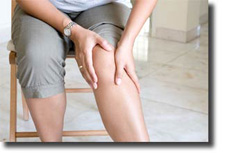Pulled Tendon

Symptoms And Treatment Of A Pulled Tendon
What is the difference between a pulled muscle and a pulled tendon? Either condition is usually painful, with the degree of pain ranging from mild to severe, depending upon the seriousness of the pull and which muscle or tendon is involved. Our ability to move around is largely based on a system of bones, ligaments, joints, muscles, and tendons. Damage to any of these individual parts can cause pain, disability, or both.
We hear the words stretched ligament, pulled muscle, and pulled or ruptured tendon fairly often, as injuries to our muscular system are not all that uncommon. Sometimes though, someone will say one thing, like “I've pulled a muscle”, when in truth a tendon or ligament, and not a muscle, has been damaged. To understand the effects of a pulled tendon, one needs to know what a tendon does as opposed to a muscle or ligament.
Ligaments, Muscles, and Tendons - The ligaments in our body are made up of fibrous tissue which connects one bone to another. Ligaments don't expand or contract in the way that muscles and tendons do, but are there mainly to provide support and stability in our joints. Without ligaments our arms and legs would move every which way, and not just in the way they are supposed to. Tendons on the other hand are cable-like connective tissue which attach muscle to bone. For example your biceps are connected to a bone in your forearm at one end and a bone in your shoulder- upper back at the other, by tendons. While our general movements, including lifting and pushing activities, are done primarily though the expansion and contraction of muscles, the tendons attached those muscles to bone also are somewhat flexible. Besides holding the muscles in place, tendons play a role not unlike shock absorbers, protecting the muscles to some degree.
Sprains and Strains - When we have a sprain, a ligament is involved, and sprains are therefore centered in the vicinity of a joint. If a muscle or tendon is involved, it's called a strain. A strain is usually less of a concern than a sprain. A sprained ankle can easily put you on crutches for a while. A strain in the ankle region can also, but usually not, and if so, usually only for a short time. A pulled tendon then is simply a more severe strain on a tendon. In the extreme case, a damaged tendon could rupture, which if in a leg or ankle could immobilize the affected person.
Grades Of Tendon Strains - When a pulled tendon occurs, the fibers in the tendon actually tear, the same as in a pulled muscle. In most cases, where the pull is not severe, the tear will heal itself. In the case of a mild tear, some pain and swelling may occur but one will usually have no problem in moving the tendon its associated muscle. This is called a Grade 1 strain. A Grade 2 strain represents a greater tearing of tendon tissues, and movement of the tendon-muscle pair may be restricted or very difficult. This would be constitute what is normally called a pulled tendon. A Grade 3 strain is where the tendon is torn to the point of rupture, and the muscle-tendon pair becomes completely immobilized. While Grade 1 and 2 strains can often be treated at home, a Grade 3 strain is going to require surgery to fix.
Remember RICE - If you suffer a pulled tendon, the initial course of treatment is rest, ice, compression and elevation, commonly known as RICE. The healing process can be very lengthy and the tendon needs to be immobilized during the initial stage of healing. It may take up to 24 hours to determine the severity of the pulled tendon, but you'll need to rest the part of your body affected for that period of time.
When To See The Doctor - If for example, you find you cannot walk without significant pain, or pick up anything with your hand, if you feel numbness, and pain and swelling are increasing, it's time to see a doctor. The healing process for a pulled tendon progresses through several stages, and can sometimes take weeks, if not months to complete. Fortunately, if you find yourself on crutches, or in a hand cast, it may only be for a few days or a couple of weeks. The latter stages of healing actually are more rapid if the affected tendon is allowed to move, carefully at first of course.
A pulled tendon is one of those injuries in which the symptoms will become steadily worse if it is severe. When this occurs, see a doctor as soon as possible, so further complications can be avoided.